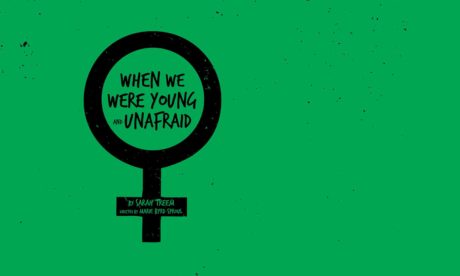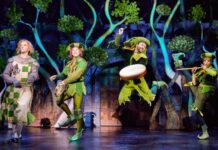On the top floor of The Keegan Theatre is a cork board labeled “What Does Feminism Mean to You?” Pushpins, pens, and slips of paper are provided so that patrons can have their say, and they do. Lots of thoughts to put a pin in. Lots of divergent points of view yet all tagged feminism. It’s an apt metaphor for the multiplicity of discrepant perspectives that Playwright Sarah Treem has packed into this passionately partisan play.
When We Were Young and Unafraid—now playing at Keegan in a production smartly directed by Marie Byrd Sproul—is set specifically in the year 1972. This was a time when there were not yet any battered women’s shelters in the United States. The very concept of “domestic violence” did not yet exist. It happened but it had no name. As Gloria Steinem famously said,
When I was growing up in Toledo, there was no such crime as domestic violence. It was called life.
Since then, women have continued to be battered, and battered women have continued to experience isolation, vulnerability, trauma, homelessness—not much has really changed. But today there are places to go for safe refuge. There are professional victim services advocates to help a woman leave her abusive partner. There is attention paid to same-sex domestic violence. There are programs for healing, hope, and a new life. Back in 1972, there was nothing of the sort.

Treem imagines a do-it-herself hero-healer named Agnes (Sheri S. Herren), who has repurposed her rustic B&B, on a small island just off the coast of Seattle, to serve as a drop-in, stay-awhile sanctuary for battered women. A former Army nurse, Agnes looks out not only for her occasional paying guests but also for her pro bono refugees from their marriage to a misogynist.
The political movement derisively then called “women’s lib” had begun, but Agnes is not an adherent. She’s uninterested. She needs no ideological conclusions about women’s place in the world to prompt or persuade her. She does what she does to help battered women because they are in trouble and need help she can provide. In Agnes, Treem has created a woman whose pro-woman actions would easily count as “feminist,” but her convictions are apolitical. She’s driven by compassion, not a cause.
Into Agnes’s world, Treem introduces four other characters, each of whom has a relationship to feminism that does get articulated as a particular politics. Turns out they have very different viewpoints about what women’s liberation means. And one of the best features of Treem’s script is how shrewdly she has her characters voice political disagreements that persist divisively within feminism today.
In a meta nutshell, these are disagreements about men. Or more precisely: how women should relate to men.
When we first meet Penny (Kaylynn Creighton), the high school student whom Agnes is raising, she is dead set against going to the prom or participating in any other superficial boy-girl rituals. She’s smarter than the boys in her classes and she knows it. She’s striving to get into to Yale (which only recently went co-ed). She has no intention of dumbing herself down to get a date.
A young woman, Mary Anne (Jenna Berk), arrives, her face bruised and a bloody bandage around her head. Her husband, John, has just brutally beaten her. She’s terrified of him, yet she’s still in love with him. The life lesson in her up-close-and-personal encounter with this man’s rage is utterly lost on her. Masochism, the self-inflicted curse of woman as a class, has made her long to go back to him.
Things get philosophically freaky when Treem brings Penny and Mary Anne into a conversation about boys and dating. Mary Anne elicits from Penny—independent, intelligent, self-possessed—an admission that she has a serious crush on the captain of the football team, but he’s oblivious of her. Seizing the opening, Mary Anne starts giving Penny tips about how to be a coquette to catch his eye, stroke his ego, and trigger his hormones. Wear a dress to school. Watch him at football practice. Smile adoringly. Touch him accidentally. Penny follows Mary Anne’s advice to the letter and in no time at all, Penny has a date to the prom.
Besides the nearly absurd disconnect here—a battered woman giving advice to a teen about how to hit on a man—there’s the acting distance Berk must stretch from bloodied victim to sagacious big sister. And Berk pulls it off with awesome virtuosity.

Another character comes by, Hannah (Nora Achrati), a butch radical lesbian on her way to a commune of separatists called the Gorgons. Hannah, as she is quick to explain, has no use for men. Her entrance would feel like a contrivance, a convenient counterpoint to Mary Anne’s and Penny’s man problems, except that Treem gives Hannah some of the best lines in the play. She quotes Ti-Grace Atkinson, for instance: “Feminism is the theory. Lesbianism is the practice.” And Achrati knocks the part out of the park.
Having set forth four perspectives on feminism from four female characters, Treem adds two male characters to the mix. One of them, John, we never see. He shows up like a beast at the gate but doesn’t crash it. His clear-and-present danger outside the B&B becomes viscerally present inside. And he too has a relationship to feminism. Hovering wordlessly over the women’s discourse, John’s disruptive appearance in the play makes the women’s disagreements seem like petty distractions from the primary emergency at hand.

Treem’s fifth character is Paul (Theo Hadjimichael), a guest at the B&B. A would-be musician, he’s a genuinely gentle soul. His relationship to feminism is that it led his wife to leave him, and he’s hurting. She got involved in consciousness-raising and lost interest in him because, she told him, he wasn’t enough of a man. His sensitivity and caring have become a liability in a world where there are liberated women who like to be manhandled in bed.
I’ve sketched here just a few of the inconsistencies in feminism that Treem’s script artfully lifts aloft and lets clash, because they comprise a big bunch of the play’s punch. They are familiar intra-movement disputes in feminism today. Many more have cropped up since 1972—such as intersectionality and trans feminism. But what’s so brilliant and engaging about When We Were Young and Unafraid is that it’s a time capsule of an era when second-wave feminism was just beginning to kick ass.
I recommend Keegan’s When We Were Young and Unafraid as not only an excellent production but also a revealing political period piece. Feminism has never been monolithic. Just check out that cork board upstairs.
Running Time: Two hours, including one intermission.
Advisory Warning: Contains sexual situations and references to domestic violence and rape. Recommended for ages 16 and older.
When We Were Young and Unafraid plays through July 8 at The Keegan Theatre—1742 Church Street NW, Washington, D.C. For tickets, call the box office at (202) 265-3767, or purchase them online.
LINK:
Review: ‘When We Were Young and Unafraid’ at The Keegan Theatre by





